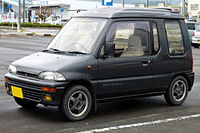
The Mazda Bongo, also known as Mazda E-Series, Eunos Cargo, and the Ford Econovan, is a cabover van and pickup truck manufactured by the Japanese automobile manufacturer Mazda since 1966. The Bongo name was also used for the Bongo Friendee, which is not a cabover design.

The Subaru Rex, also known as Ace, Viki, Sherpa, 500/600/700, Mini Jumbo, Mini Subaru or M60/M70/M80 in various export markets, is a kei class automobile produced from 1972 to 1992 mainly for sale in Japan by Subaru, although it was also sold in Europe, South America, Australia and the Caribbean. The Rex superseded the R-2 as Subaru's kei car, and has been available in commercial use versions as well as in a passenger car version. It underwent major changes in 1976, in fall 1981, and again in late 1986. The second generation Rex (1981–1986) also formed the basis for the larger Subaru Justy.
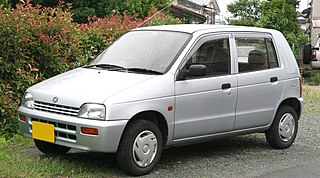
The Suzuki Alto is a kei car produced by Suzuki since 1979. The model, currently in its ninth generation, was first introduced in 1979 and has been built in many countries worldwide. The Alto originated as a commercial vehicle derivative of the Fronte, but over time the Alto nameplate gained in popularity and by 1988 it replaced the Fronte name completely. The Alto badge has often been used on different cars in Japan and in export markets, where it is considered a city car.

The Mitsubishi Colt is a nameplate from Mitsubishi Motors that has been applied to a number of automobiles since 1962. It was first introduced with a series of kei and subcompact cars in the 1960s, and then for the export version of the subcompact Mirage between 1978 and 2002. Chrysler, Mitsubishi's longtime partner, also used the name when applying its long-running practice of rebadging Mitsubishi vehicles as the Dodge and Plymouth Colt captive imports for the North American market between 1970 and 1994.

The Mitsubishi Pajero Mini is a kei car produced by Mitsubishi Motors from December 1994 until June 2012.

The Mitsubishi Minica is a model series of kei cars, produced by Mitsubishi Motors Corp. (MMC) over five generations, from 1962 to 2011, mainly for the Japanese domestic market.
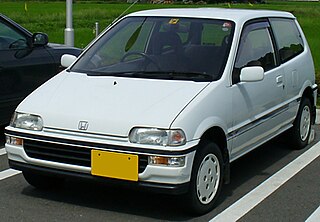
The Honda Today is a kei car produced by Japanese automaker Honda beginning in 1985. It was replaced by the Honda Life in 1998.

The Mitsubishi Chariot is an automobile manufactured and marketed by Mitsubishi from 1983 to 2003. It is a small multi-purpose vehicle (MPV). Based on the SSW concept car first exhibited at the 23rd Tokyo Motor Show in 1979, the MPV derives its nameplate from chariots used by the ancient Greek and Roman empires.
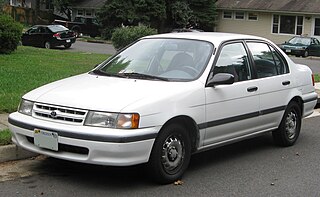
The Toyota Tercel is a subcompact car manufactured by Toyota from 1978 until 1999 across five generations, in five body configurations sized between the Corolla and the Starlet. Manufactured at the Takaoka plant in Toyota City, Japan, and sharing its platform with the Cynos and the Starlet, the Tercel was marketed variously as the Toyota Corolla II—sold at Toyota Japanese dealerships called Toyota Corolla Stores—and was replaced by the Platz in 1999. It was also known as the Toyota Corsa and sold at Toyopet Store locations. Starting with the second generation, the Tercel dealership network was changed to Vista Store, as its badge engineered sibling, the Corolla II, was exclusive to Corolla Store locations.

The Daihatsu Hijet is a cab over microvan and kei truck produced and sold by the Japanese automaker Daihatsu since 1960. Despite the similarities between the Hijet name and Toyota's naming scheme for its trucks and vans, the name "Hijet" has been in use for Daihatsu's kei trucks and microvans since 1960, over two decades before Toyota took control. "Hijet", when transliterated into Japanese, is very similar to "Midget", one of Daihatsu's other mini-trucks. According to Daihatsu, the name "Hijet" was created to imply that the vehicle offers higher performance than the Midget. The Hijet competes in Japan with the Honda Acty, Mitsubishi Minicab, Nissan Clipper, Subaru Sambar and Suzuki Carry.

The Honda Acty is a series of cabover microvans and kei trucks produced by the Japanese automaker Honda from 1977 to 2021, designed for the Japanese domestic market (JDM). "Acty" is short for "Activity".

The Mitsubishi Galant VR-4 was the range-topping version of Mitsubishi Motors' Galant model, available in the sixth (1987–1992), seventh (1992–1996) and eighth (1996–2002) generations of the vehicle. Originally introduced to comply with the new Group A regulations of the World Rally Championship, it was soon superseded as Mitsubishi's competition vehicle by the Lancer Evolution, and subsequently developed into a high-performance showcase of the company's technology.

The Mitsubishi Delica is a range of vans and pickup trucks designed and built by the Japanese automaker Mitsubishi Motors since 1968. It was originally based on a cabover van and pickup truck introduced the previous year, also called the Delica, its name a contraction of the English language phrase Delivery car. This pickup truck, and a commercial van derived from it has received many names in export markets, being sold as the L300 in Europe, Jamaica and New Zealand, Express and Starwagon in Australia, and plain Mitsubishi Van and Wagon in the United States. The passenger car versions were known as Delica Star Wagon from 1979 until the 1994 introduction of the Delica Space Gear, which became simply Space Gear in Europe at least. The most recent version is called the Delica D:5. With the exception of the first, versions of all generations are still being sold in various international markets.

The Mitsubishi eK is a kei car series from Mitsubishi Motors, based on the long-running Minica, and first introduced on October 11, 2001. The "eK" name is an abbreviation for "excellent keijidōsha" and is meant to be pronounced "ee kay", a pun which sounds like the Japanese いい軽, meaning "good kei [car]".

The Mitsubishi 4A3 engine is a range of alloy-headed inline four-cylinder engines from Mitsubishi Motors, introduced in 1993 in the sixth generation of their Mitsubishi Minica kei car. It shares a 72 mm (2.8 in) bore pitch with the 3G8-series three-cylinder engines, but has a considerably shorter stroke so as to stay beneath the 660 cc limit imposed by the Kei class.
The Mitsubishi Town Box is a kei car and minivan produced for the Japanese domestic market (JDM) by the Japanese automaker Mitsubishi Motors. It was initially available with the alloy-headed 4A30 657 cc inline-four engine, but switched to the 3G83 659 cc straight-three engine in 2002. From June 1999 until August 2001, a slightly larger version of the same vehicle powered by a 4A31 1.1 L straight-four, the Mitsubishi Town Box Wide, was also available. The first generation Town Box was discontinued in November 2011, ending the twelve-year production run. The nameplate returned in February 2014 on a rebadged version of the Suzuki Every Wagon.

The Mitsubishi Minicab is a kei truck and microvan, built and sold in Japan by Japanese automaker Mitsubishi Motors since 1966. In Japan, it was sold at a specific retail chain called Galant Shop. It was also sold by China Motor Corporation (CMC) in Taiwan as the CMC Veryca, starting in 1985. A battery electric model of the Minicab, called the Minicab MiEV, is sold in the Japanese market since December 2011.

The Suzuki Carry is a kei truck produced by the Japanese automaker Suzuki. The microvan version was originally called the Carry van until 1982 when the passenger van versions were renamed as the Suzuki Every. In Japan, the Carry and Every are kei cars but the Suzuki Every Plus, the bigger version of Every, had a longer bonnet for safety purposes and a larger engine; export market versions and derivatives have been fitted with engines of up to 1.6 liters displacement. They have been sold under myriad different names in several countries, and is the only car to have been offered with Chevrolet as well as Ford badges.
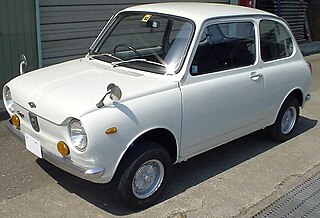
The Subaru R-2 is a kei car manufactured by Subaru from 1969 to 1972. The R-2 was a full model change of the popular Subaru 360, but with an updated appearance and increased interior space. The R-2 appeared approximately one year before the Honda Life, Daihatsu Fellow Max and Suzuki Fronte kei cars, however, it continued to use the powertrain setup from the Subaru 360, which was the EK33 air-cooled 2-cylinder engine installed in the back, which is the inspiration for the name of the vehicle. It appeared around the same time as the second generation Mitsubishi Minica.

The Mitsubishi Lancer (A70) is the first generation version of Mitsubishi's long-running Lancer nameplate. When introduced in 1973, it filled the gap between the Minica kei car and the considerably larger Galant. It was a replacement for the Colt 1200, last sold in 1970. Although sedan production ended in 1979, vans continued on until 1985. This Lancer also formed the basis for the Lancer Celeste sports coupé of 1975 through to 1981. These Lancers were sold under a multitude of names in different markets.



